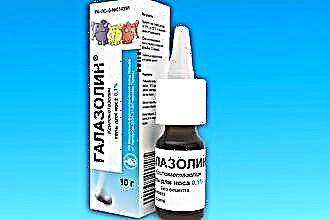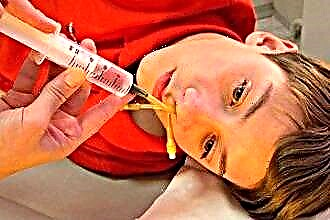In most cases, nosebleeds (epistaxis) are not dangerous. It is quite common in both adults and children. In the nasal mucosa, there are many small vessels that can break against the background of temperature changes or colds. Usually, this is not dangerous to health, but sometimes excessive loss can be accompanied by unpleasant symptoms: dizziness, delirium, confusion in the head, fainting, vomiting and coughing (if blood enters the stomach or respiratory tract through the nasopharynx).
What can cause nosebleeds?
In order to start the treatment of epistaxis, you need to know what conditions can provoke it. These include:
 irritation, dryness of the nasal membrane, persistent runny nose;
irritation, dryness of the nasal membrane, persistent runny nose;- fragility and weakness of the walls of blood vessels;
- hypertonic disease;
- increased intracranial pressure;
- acute reaction to stress, overwork;
- side effect of drugs;
- the use of aspirin (due to the antithrombotic effect);
- polyps in the nose;
- use of cocaine;
- blood clotting disorders, hemophilia;
- hypothyroidism;
- vascular atherosclerosis;
- anemia.
Epistaxis, as a patient's complaint, can be encountered by specialists of different medical profiles: cardiologist, endocrinologist, neurologist.
Nosebleeds are divided into two main types according to the localization of occurrence: anterior and posterior. The anterior ones appear most often against the background of injuries, damage to the wall of the nose and blood vessels. The posterior ones are in case of systemic diseases, blood diseases, and arise as a result of blood sweating through the vessels (diapedesis).
A nasal hemorrhage during pregnancy can begin for several reasons: first, the level of female sex hormones (estrogens and progesterone) increases, which affect blood circulation and the fullness of the arteries. In parallel with this, the body's reserves of vitamin K and calcium are depleted, which are necessary to strengthen the walls of blood vessels. As a result, the nasal mucosa swells, becomes loose, and the capillaries become thinner. In addition to this, in women in position, an increased load on the cardiovascular system and the liver, which are involved in the formation of coagulation factors, is determined.
After childbirth, the condition stabilizes and the woman's health usually returns to normal.
Epistaxis in children occurs due to anatomical features: the mucous membrane is thin, and the vessels are very close to it.
In adolescents, and in particular in girls, the cause may be an increase in estrogen and increased nasal blood flow.
In older people, due to aging, the vascular wall becomes thinner and hypertension often appears. Such patients often take blood thinning pills, which becomes an additional risk of various types of bleeding.
When does nose bleed most often?
It is said that with high blood pressure, nosebleeds. This belief is supported by standard textbooks on otorhinolaryngology and general medicine, but at this point in time there is no conclusive research to support this fact. There are only guesses coming from the fundamental sciences: the structure of the human body, in particular the vessels.
Increased pressure: an inside look
 Hypertension is a common condition in which the blood flowing through the arteries puts high pressure on the walls of the vessels, causing certain problems. Therefore, excessive tension of the walls of blood vessels, together with their increased fragility, impaired blood clotting (or other concomitant pathologies), can be the cause of epistaxis. In addition, high blood pressure contributes to vascular damage and their further hardening.
Hypertension is a common condition in which the blood flowing through the arteries puts high pressure on the walls of the vessels, causing certain problems. Therefore, excessive tension of the walls of blood vessels, together with their increased fragility, impaired blood clotting (or other concomitant pathologies), can be the cause of epistaxis. In addition, high blood pressure contributes to vascular damage and their further hardening.
Clinically, nosebleeds associated with hypertension can be accompanied by pain and noise in the head, flies before the eyes, tachycardia, and anxiety.
It is easy to prevent this process: it is enough to control the AT indicators using a tonometer. Now this is especially true, because most hypertensive patients are susceptible to stress, which is a trigger for an exacerbation of the disease.
Low pressure
The relationship between these processes is not well understood, but there is an assumption that this situation is possible due to anemia, which is manifested by hypotension. In addition, uncontrolled or inappropriate use of antihypertensive drugs leads to blood thinning and increased vascular permeability, which can cause bleeding. So, if nosebleed with low pressure appears while taking medication, you need to stop taking medications or change the dosage.
What to do with the onset of nosebleeds?
 If the process has already begun, the first step is to stop the blood loss. The most common mistake is tilting the head back, which can lead to blood entering the digestive tract or respiratory tract. Therefore, it is better to take a sitting position, tilt your head forward and breathe through your mouth.
If the process has already begun, the first step is to stop the blood loss. The most common mistake is tilting the head back, which can lead to blood entering the digestive tract or respiratory tract. Therefore, it is better to take a sitting position, tilt your head forward and breathe through your mouth.
To directly stop bleeding, a mechanical method is used (squeezing the wings of the nose with fingers or a special clothespin), physical (exposure to cold to reduce the diameter of blood vessels: ice, snow).
In order to prevent vomiting, you need to spit out blood.
All of these methods will help you stop bleeding in 15-20 minutes, provided there are no clotting disorders. If the problem is not resolved, this is a reason to call an ambulance.
What is not recommended:
- perform manipulations that can injure the nasal mucosa within 12 hours after the termination of epistaxis (forcefully blow out air through the nostrils, thrust any objects into the nasal cavity);
- independently remove the tampon that the doctor placed to stop blood loss;
- Drinking hot liquids or eating hot foods within 24 hours
- Exercise or lift heavy objects for the next few days
- smoke cigarettes;
- lean sharply;
- take a hot bath or shower;
- take any drugs.
All of the above can provoke a quick re-attack.
How to stop bleeding during exacerbation of hypertension?
 To stop, it is necessary to carry out all the same steps as for the routine stop of epistaxis described above. The only difference is that it is necessary to simultaneously carry out an emergency correction of the underlying disease by taking antihypertensive drugs (for example, beta-blockers, calcium channel blockers, angiotensin-converting enzyme inhibitors, angiotensin II antagonists, sartans).
To stop, it is necessary to carry out all the same steps as for the routine stop of epistaxis described above. The only difference is that it is necessary to simultaneously carry out an emergency correction of the underlying disease by taking antihypertensive drugs (for example, beta-blockers, calcium channel blockers, angiotensin-converting enzyme inhibitors, angiotensin II antagonists, sartans).
Prevention of nosebleeds:
- use a humidifier at night to combat dry nose;
- quitting smoking, both active and passive;
- while sneezing, open your mouth so that there is no excess pressure in the nasal cavity;
- it is important for children to keep their nails in order and short-cut due to the bad habit of damaging the nasal cavities with their help;
- monitor the state of blood pressure using daily monitoring with a tonometer.
Conclusions
Epistaxis is a common pathology that can be accompanied by unpleasant symptoms, especially with improper first aid. Therefore, it is necessary to know the basic rules for stopping this condition and have an idea of possible complications.People with hypertension or vascular pathology should be especially alert.

 irritation, dryness of the nasal membrane, persistent runny nose;
irritation, dryness of the nasal membrane, persistent runny nose;

